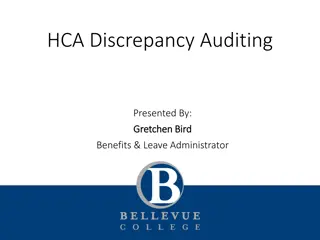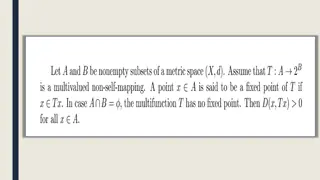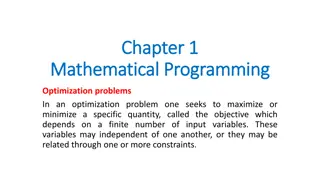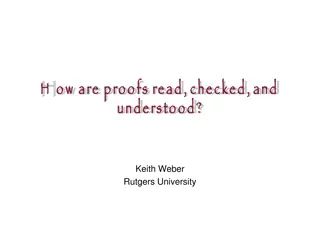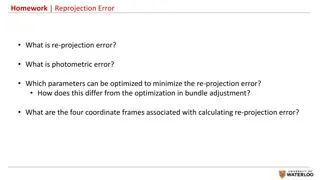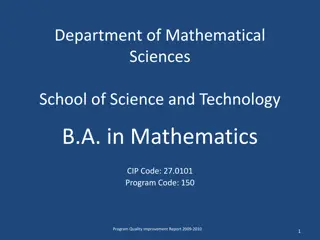Understanding Discrepancy and Optimization in Mathematical Analysis
Discrepancy and Optimization, explored by Nikhil Bansal, delve into irregularities when approximating continuous data with discrete points. This concept addresses the challenge of distributing points uniformly in a grid and optimizing numerical integration or sampling techniques. Additionally, it touches upon Quasi-Monte Carlo methods and dynamic data structures for handling weighted points in a 2D region efficiently.
Download Presentation

Please find below an Image/Link to download the presentation.
The content on the website is provided AS IS for your information and personal use only. It may not be sold, licensed, or shared on other websites without obtaining consent from the author. Download presentation by click this link. If you encounter any issues during the download, it is possible that the publisher has removed the file from their server.
E N D
Presentation Transcript
Discrepancy and Optimization Nikhil Bansal (CWI and TU/e)
Discrepancy: What is it? Study of irregularities in approximating the continuous by the discrete. Original motivation: Numerical Integration/ Sampling How well can you approximate a region by discrete points ?
Discrepancy: What is it? Problem: How uniformly can you distribute n points in a grid. Uniform : For every axis-parallel rectangle R | (# points in R) - (Area of R) | should be low. Discrepancy: Max over rectangles R |(# points in R) (Area of R)| R n1/2 n1/2
Distributing points in a grid Problem: How uniformly can you distribute n points in a grid. Uniform : For every axis-parallel rectangle R | (# points in R) - (Area of R) | should be low. n= 64 points Uniform Random n1/2 (loglog n)1/2 Van der Corput Set O(log n) discrepancy! n1/2 discrepancy
Quasi-Monte Carlo Methods 1 ? n random samples (Monte Carlo) : Error Quasi-Monte Carlo Methods* : ???? *Different constant of proportionality ? Extensive research area.
Combinatorial Discrepancy S3 Universe: U= [1, ,n] Subsets: S1,S2, ,Sm S4 S1 Color elements red/blue so each set is colored as evenly as possible. S2 Given : [n] ! { -1,+1} Disc (?) = maxS | i2S (i)| = maxS ? Disc (set system) = min? maxS ?
Tusnadys problem Input: n points placed arbitrarily in a grid. Sets = axis-parallel rectangles Discrepancy: max over rect. R ( |# red in R - # blue in R| ) Random gives about O(n1/2 log1/2 n) Very long line of work O(log4n) [Beck 80 s] ... O(log2.5n) [Matousek 99] O(log2n) [B., Garg 16] O(log1.5 n) [Nikolov 17]
Application: Dynamic Data Structures N weighted points in a 2-d region. Weights updated over time. Query: Given an axis-parallel rectangle R, determine the total weight on points in R. Goal: Preprocess (in a data structure) 1) Low query time 2) Low update time (upon weight change)
Example Line: Interval queries Trivial: Query Time= O(n) Update Time = 1 Query = 1 Update = O(?2) (Table of entries W[a,b] ) Query = 2 Update = O(n) (W[a,b] = W[0,b] W[0,a]) Query = O(log n) Update = O(log n) Recursively for 2-d. ? log2?,log2?
What about other queries? Circles arbitrary rectangles aligned triangle ?1/2 log2? Turns out ???? Reason: Set system S formed by query sets & points has large discrepancy (about ?1/4) Larsen-Green 11: ???? ???? ?2 log2?
Applications CS: Computational Geometry, Approximation, Complexity, Differential Privacy, Pseudo-Randomness, Math: Combinatorics, Finance, Dynamical Systems, Number Theory, Ramsey Theory, Algebra, Measure Theory,
Matrix View Rows: sets Columns: elements Given any matrix A, find coloring ? 1,1?, to minimize ??
Optimization Jobs Machines Scheduling Clustering Travelling Salesman NP-Hard Polynomial time relaxation Min cx Ax = b x {0,1} Min cx Ax = b x [0,1] rounding
Rounding Lovasz-Spencer-Vesztermgombi 86: Given any matrix A, and ? ??, can round x to ? ??s.t. ?? ? ? < Herdisc ? ? x Ax=b Proof: Round the bits of x one by one. ?1: blah .0101101 ?2: blah .1101010 ??: blah .0111101 (-1) Key Point: Low discrepancy coloring guides our updates! A (+1) Error = herdisc(A) ( 1 2? 1 + +1 1 2) 2?+
Rounding: The Catch LSV 86 result guarantees existence of good rounding. But, how to find it efficiently (poly time)? Nothing known until recently.
Questions around Discrepancy bounds Combinatorial: Show good coloring exists Algorithmic: Find coloring in poly time Lower bounds on discrepancy (do not focus here)
Combinatorial (3 generations) 0) Linear Algebra (Iterated Rounding) [Steinitz, Beck-Fiala, Barany, ] 1) Partial Coloring Method: Beck/Spencer early 80 s: Probabilistic Method + Pigeonhole Gluskin 87: Convex Geometric Approach Very versatile (black-box) Loss adds over O(log n) iterations 2) Banaszczyk 98: Based on a deep convex geometric result Produces full coloring directly (also black-box)
Brief History (combinatorial) Method Tusnady (rectangles) Beck-Fiala (low deg. system) log4? Linear Algebra t log2.5? [Matousek 99] Partial Coloring t1/2 log n log1.5? [Nikolov 17] Banaszczyk (t log n)1/2 [Banaszczyk 98] Lower bound t1/2 log ?
Algorithmic history Linear Algebraic Methods: Already algorithmic Partial Coloring now constructive Bansal 10: SDP + Random walk Lovett Meka 12: Random walk + linear algebra Rothvoss 14: Convex geometric Many others by now [Harvey, Schwartz, Singh], [Eldan, Singh] Banaszczyk based approaches: [B.-Dadush-Garg 16]: ?log?1/2 algorithm for (specific) Beck-Fiala problem [B.-Garg 17]: A more general framework, e.g. ? log2? for Tusnady. [B. Dadush Garg Nikolov 18]: Algorithm for general Banaszczyk.
Several Successes Meta-Problem: Ideas for discrepancy lead to new rounding techniques for optimization problems 3 2 4 2 4 Bin Packing ! 1 3 1 Combines randomized and iterated rounding [B., Nagarajan 16, ] (two very powerful but quite orthogonal approaches) Big Goal: Currently algorithm design: quite adhoc, problem specific approaches. Discover general principles that unify + improve existing approaches
Optimization in Practice Model your program as (mixed) integer program. Use solver like CPLEX or Gurobi Various heuristics: Branch & bound, Cutting planes, Preprocessing, Big mystery why they work so well (on real world instances) Could we explain/understand this success theoretically? Could techniques from discrepancy help in improving heuristics? Workshop: Discrepancy theory and Integer Prog. (Jun 11-15, CWI) (more info on Daniel Dadush s webpage)






